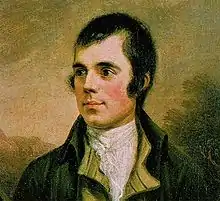Auld Lang Syne
"Auld Lang Syne" (Scots pronunciation: [ˈɔːl(d) lɑŋˈsəin]: note "s" rather than "z")[1] is a popular song, particularly in the English-speaking world. Traditionally, it is sung to bid farewell to the old year at the stroke of midnight on New Year's Eve. By extension, it is also often heard at funerals, graduations, and as a farewell or ending to other occasions; for instance many branches of the Scouting movement use it to close jamborees and other functions.[2]

The text is a Scots-language poem written by Robert Burns in 1788[3][4] but based on an older Scottish folk song. In 1799, it was set to a traditional tune, which has since become standard. "Auld Lang Syne" is listed as numbers 6294 and 13892 in the Roud Folk Song Index.
The poem's Scots title may be translated into standard English as "old long since" or, less literally, "long long ago",[5] "days gone by", "times long past" or "old times". Consequently, "For auld lang syne", as it appears in the first line of the chorus, might be loosely translated as "for the sake of old times".
The phrase "Auld Lang Syne" is also used in similar poems by Robert Ayton (1570–1638), Allan Ramsay (1686–1757), and James Watson (1711), as well as older folk songs predating Burns.[6] Matthew Fitt uses the phrase "in the days of auld lang syne" as the equivalent of "once upon a time" in his retelling of fairy tales in the Scots language.[7]
History
Text
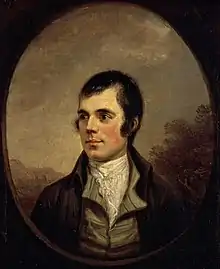
Robert Burns sent a copy of the original song to the Scots Musical Museum in 1788 with the remark, "The following song, an old song, of the olden times, and which has never been in print, nor even in manuscript until I took it down from an old man."[8] Some of the lyrics were indeed "collected" rather than composed by the poet; the ballad "Old Long Syne" printed in 1711 by James Watson shows considerable similarity in the first verse and the chorus to Burns' later poem,[6] and is almost certainly derived from the same "old song". To quote from the first stanza of the James Watson ballad:
Should Old Acquaintance be forgot,
and never thought upon;
The flames of Love extinguished,
and fully past and gone:
Is thy sweet Heart now grown so cold,
that loving Breast of thine;
That thou canst never once reflect
On old long syne.
Chorus:
On old long syne my Jo,
On old long syne,
That thou canst never once reflect,
On old long syne.
It is a fair supposition to attribute the rest of the poem to Burns himself.[8]
There is some doubt as to whether the melody used today is the same one Burns originally intended, but it is widely used in Scotland and in the rest of the world.[4][9]
Singing the song on Hogmanay or New Year's Eve very quickly became a Scots custom that soon spread to other parts of the British Isles. As Scots (not to mention English, Welsh and Irish people) emigrated around the world, they took the song with them.
Melody

The tune to which "Auld Lang Syne" is commonly sung is a pentatonic Scots folk melody, probably originally a sprightly dance in a much quicker tempo. The song originally had another melody, which can be traced to around 1700 and was deemed "mediocre" by Robert Burns. The famous melody was first used in 1799, in the second volume of George Thomson's Select Songs of Scotland.[10]
Older versions of the original song which use other melodies have survived in isolated Scottish communities. The American folk song collector James Madison Carpenter collected a version of "Auld Lang Syne" which appears to be distantly related to the original folk song version from a man named William Still of Cuminestown, Aberdeenshire in the early 1930s. William Still can be heard singing the song on the Vaughan Williams Memorial Library website.[11]
Lyrics
The song begins by posing a rhetorical question: Is it right that old times be forgotten? The answer is generally interpreted as a call to remember long-standing friendships.[10] Alternatively, "Should" may be understood to mean "if" (expressing the conditional mood) referring to a possible event or situation.
George Thomson's Select Songs of Scotland was published in 1799 in which the second verse about greeting and toasting was moved to its present position at the end.[10]
Most common usage of the song involves only the first verse and the chorus. The last lines of both of these are often sung with the extra words "For the sake of" or "And days of", rather than Burns's simpler lines. This makes the song strictly syllabic, with just one note per syllable.
| Burns's original Scots verse[5] | Standard English version (singable) |
Scots pronunciation guide (as Scots speakers would sound) |
IPA pronunciation guide (Burns's own Ayrshire dialect)[12] |
|---|---|---|---|
Should auld acquaintance be forgot, |
Should old acquaintance be forgot, |
Shid ald akwentans bee firgot, |
ʃɪd o̜ːld ə.kwɛn.təns bi fər.ɡot |
- Scots "lang syne" (close cognate with standard English "long since". Variations are 'Syn', and 'Sin', all being contracted forms of 'Sithen'). Properly pronounced with a hard "S" (like "sign") rather than the soft "Z" sound usually sung.
- dine = "dinner time"
- ch = voiceless velar fricative, /x/, at the back of the mouth like /k/; similar to "Bach" in German
Settings and quotations of the melody
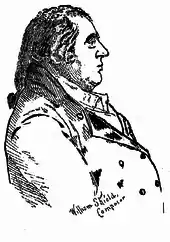
English composer William Shield seems to quote the "Auld Lang Syne" melody briefly at the end of the overture to his opera Rosina (1782), which may be its first recorded use. The contention that Burns borrowed the melody from Shield is for various reasons highly unlikely, although they may very well both have taken it from a common source, possibly a strathspey called "The Miller's Wedding" or "The Miller's Daughter".[13] The problem is that tunes based on the same set of dance steps necessarily have a similar rhythm, and even a superficial resemblance in melodic shape may cause a very strong apparent similarity in the tune as a whole. For instance, Burns' poem "Comin' Thro' the Rye" is sung to a tune that might also be based on the "Miller's Wedding". The origin of the tune of "God Save the Queen" presents a very similar problem and for just the same reason, as it is also based on a dance measure.[14] (See the note in the William Shield article on this subject.)
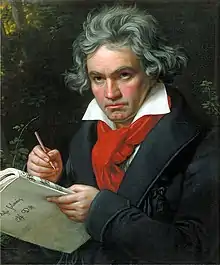
In 1792, the Austrian composer Joseph Haydn arranged Auld Lang Syne as one of over 400 Scottish folk song arrangements commissioned by George Thomson and the publishers William Napier and William Whyte;[15] his arrangement may have helped popularise the song.[16] Ludwig van Beethoven also wrote an arrangement of Auld Lang Syne (WoO 156/11) published as part of his 12 Scottish Folksongs (1814). Both of these classical versions use the original brisk strathspey rhythm.
In 1855, different words were written for the Auld Lang Syne tune by Albert Laighton and titled, "Song of the Old Folks". This song was included in the tunebook, Father Kemp's Old Folks Concert Tunes published in Boston, Massachusetts, in 1860.[17] For many years it was the tradition of the Stoughton Musical Society to sing this version in memory of those who had died that year.
Songwriter George M. Cohan quotes the first line of the "Auld Lang Syne" melody in the second to last line of the chorus of “You're a Grand Old Flag”. It is plain from the lyrics that this is deliberate; the melody is identical except the first syllable of the word "forgot".
John Philip Sousa quotes the melody in the Trio section of his 1924 march "Ancient and Honorable Artillery Company".
English composer of light music Ernest Tomlinson wrote a Fantasia on Auld Lang Syne (1976), which in its 20 minutes weaves in 152 quotations from pieces by other popular and classical composers.[18]
In the Sacred Harp choral tradition, an arrangement of it exists under the name "Plenary". The lyrics are a memento mori and begin with the words "Hark! from the tomb a doleful sound". Another Christian setting, using the name "Fair Haven" for the same tune, uses the text "Hail! Sweetest, Dearest Tie That Binds" by Amos Sutton.[19] In a similar vein, in 1999 Cliff Richard released a setting of the Lord's prayer (as "The Millennium Prayer") to the melody.[20]
British soldiers in World War I trenches sang "We're Here Because We're Here" to the tune of "Auld Lang Syne".[21]
This tune was used briefly in the 1930 Mickey Mouse cartoon The Chain Gang.[22]
When sung
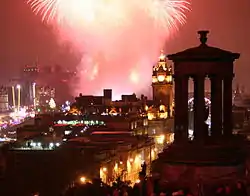
At New Year
"Auld Lang Syne" is traditionally sung at the conclusion of New Year gatherings in Scotland and around the world, especially in English-speaking countries.
At Hogmanay in Scotland, it is common practice that everyone joins hands with the person next to them to form a great circle around the dance floor. At the beginning of the last verse (And there's a hand, my trusty fiere!/and gie's a hand o' thine!), everyone crosses their arms across their breast, so that the right hand reaches out to the neighbour on the left and vice versa.[23][24] When the tune ends, everyone rushes to the middle, while still holding hands. When the circle is re-established, everyone turns under the arms to end up facing outwards with hands still joined. The tradition of singing the song when parting, with crossed hands linked, arose in the mid-19th century among Freemasons and other fraternal organisations.[25][26]
Outside Scotland the hands are often crossed from the beginning of the song, at variance with Scottish custom. The Scottish practice was demonstrated by Queen Elizabeth II at the Millennium Dome celebrations for the year 2000. Some press outlets berated her for not "properly" crossing her arms, unaware that she was correctly following the Scottish tradition.[27][28]
At other times
As well as celebrating the New Year, "Auld Lang Syne" is very widely used to symbolise other "endings/new beginnings" – including farewells, funerals (and other memorials of the dead), graduations, the end of a (non-New Year) party, jamborees of the Scout Movement, the election of a new government, the last lowering of the Union Jack as a British colony achieves independence[29] and even as a signal that a retail store is about to close for the day. The melody is also widely used for other words, especially hymns, the songs of sporting and other clubs, and even national anthems (South Korea in the 1940s, and the Maldives until 1972). In Scotland and other parts of Britain, in particular, it is associated with celebrations and memorials of Robert Burns. The following list of specific uses is far from comprehensive.[30][31][2]
In the English-speaking world
.jpg.webp)
- In Scotland, it is often sung at the end of a cèilidh, a dance, and at weddings. At weddings, it is performed in the same way as at New Year, but the bride and groom are often lifted up in the centre of the circle.
- The tune is played, and sung by the crowd, in the final stages of the annual Edinburgh Military Tattoo.
- In many Burns Clubs, it is sung at the end of the Burns supper.
- In Great Britain, it is played at the close of the annual Congress (conference) of the Trades Union Congress. It is also usually the final song of the Liberal Democrat Glee Club.
- The song is sung at the end of the Last Night of the Proms. Depending on whether an "official" performance is planned it may not be listed on the programme but in this case the audience will maintain the tradition and sing it themselves, with or without backup from the performers.
- The song is played at the Passing Out Parade of Young Officers in the Royal Navy as they march up the steps of the Britannia Royal Naval College; for Royal Air Force officers at Royal Air Force College Cranwell, and at the Sovereign's Parade at the Royal Military Academy Sandhurst for young officers joining the British Army, as the cadets march up the steps of their famous Old College building – to the beat of the slow march, after the tune "Will ye no come back?". This custom (or something very like it) is also followed in Naval and Military colleges in many other countries, especially members and former members of the Commonwealth of Nations. Examples include the Royal Military College of Canada, the Royal Military College (Malaysia), the National Defence Academy (India),[32] the Pakistan Military Academy, Bangladesh Military Academy and at the equivalent colleges in Singapore, Burma and Nigeria.
- The song is very widely used by the international Scout Movement, where it is a popular closing song for jamborees and other occasions.[2][31][30]
In non-English-speaking countries
"Auld Lang Syne" has been translated into many languages, and the song is widely sung all over the world. The song's pentatonic scale matches scales used in Korea, Japan, India, China and other Asian countries, which has facilitated its "nationalisation" in the East. The following particular examples mostly detail things that are special or unusual about the use of the song in a particular country.
- In Denmark, the song was translated in 1927 by the Danish poet Jeppe Aakjær. Much like Robert Burns' use of dialect, Aakjær translated the song into Sallingbomål, a form of the Jutlandic dialect. The song "Skuld gammel venskab rejn forgo" is an integral part of the Danish Højskole tradition, and often associated with more rural areas and old traditions.
- In the Netherlands, the melody is used as the Dutch football song "Wij houden van Oranje" ("We Love Orange"), performed by André Hazes.
- In Germany, the lyrics are "Nehmt Abschied, Brüder", traditionally performed at New Year and often at the end of an event. The melody was adapted to the German text in 1946 von Claus Ludwig Laue.
- In West Bengal and Bangladesh, the melody was the direct inspiration for the Bengali folk song "Purano shei diner kotha" ("Memories of the Good Old Days"), composed by Nobel laureate Rabindranath Tagore,[33][34] and forms one of the more recognisable tunes in Rabindra Sangeet ("Rabindra's Songs"), a body of work of 2,230 songs and lyrical poems that form the backbone of Bengali music.
- In Thailand, the song "Samakkhi Chumnum" (สามัคคีชุมนุม, 'together in unity') is set to the same melody. It is mainly sung after sporting fixtures and at the end of Boy Scout jamborees. The Thai lyrics are a patriotic song about the King and national unity, and many Thais are not aware of the song's Western origin.[35]
- In Japan, the melody is used for the song "Hotaru no Hikari" (The Light of the Fireflies), which has different lyrics. "Hotaru no Hikari" is played at many school graduation ceremonies, and at the end of the New Year's Eve show NHK Kōhaku Uta Gassen. It is played in various establishments such as bars, restaurants, or department stores in Japan to let the customers know that the establishment is closing soon.[36]
- In Korea, the song is known as "Jakbyeol" (작별, Farewell) or (less commonly) as "Seokbyeol-ui Jeong" (석별의 정, The Feeling of Farewell). From 1919 to 1945 it served as the national anthem of the Korean exile government and from 1945 to 1948, it was the melody of Korea's national anthem. The lyrics used then were the same as the current South Korean national anthem.[37]
- In Francophone areas, the song is known as "Ce n'est qu'un au revoir" ["it is but a farewell"]. The French lyrics are not a literal translation of the original lyrics, and instead talk about people saying farewell, knowing they will meet again.
- Before 1972, it was the tune for the anthem of the Maldives (with the current words).
- In the mid-1980s, Afro-Peruvian singer Pepe Vásquez popularized a festejo-rhythm version called Jipi jay.
Use in films
The strong and obvious associations of the song and its melody have made it a common staple for film soundtracks from the very early days of "talking" pictures to the present—a large number of films and television series' episodes having used it for background, generally but by no means exclusively to evoke the New Year.
Notable performances
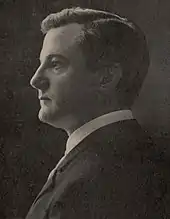
Recordings
The first recording of the song was made on wax cylinder in 1898 by the Englishmen Charles Samuel Myers and Alfred Cort Hadden, who sang it in a demonstration of the new technology whilst on an expedition to record Aboriginal Australian music with figures including Charles Seligman, W. H. R Rivers and Sidney Herbert Ray. The original 1898 recording can be heard online via the British Library Sound Archive website.[38]
The first commercial recording was probably that of Frank C Stanley, who recorded the song in 1910 (which can be heard above).
As a standard in music, "Auld Lang Syne" has since been recorded many times, in every conceivable style, by many artists, both well-known and obscure.
In late 1999, an instrumental rendition by American saxophonist Kenny G reached No. 7 on the Billboard Hot 100 upon release as a single. At the time of charting it was the oldest-written song to make the Hot 100 charts.[39]
Live and broadcast
- 1929: Guy Lombardo and His Royal Canadians performed it on New Year's Eve for decades until his death in 1977. Lombardo's 1947 Decca Records version is played in Times Square every New Year's immediately following the dropping of the ball.[40]
- 1997: On 30 June, the day before Hong Kong was handed over from the United Kingdom to the People's Republic of China, the tune was played by the silver and pipe bands from the Royal Hong Kong Police Force, at the departure of Hong Kong's 28th and last British Governor, Chris Patten, from his official residence, Government House, Hong Kong.[41]
- 2009: On 30 November – St. Andrew's Day – students and staff at the University of Glasgow sang the song in 41 languages simultaneously.[42]
- 2015: On 25 March, the song was performed by a bagpiper from the Singapore Police Force's Gurkha Contingent Pipes and Drums Platoon at The Istana as a form of respect to the late prime minister of Singapore Lee Kuan Yew during his state funeral.[43]
- 2020: On 29 January, the song was sung by members of the European Parliament when the Brexit withdrawal agreement was passed, ending the UK's membership in the European Union, finalised two days later on 31 January.[44]
- 2022: On 20 February, at 21:40 CST, the song was sung in Mandarin Chinese to mark the end of the 2022 Winter Olympics closing ceremony.[45]
References
- Rennie, Susan (ed.). "Lang Syne". Dictionary of the Scots Language. Archived from the original on 19 January 2012. Retrieved 1 January 2012.
- Honeck, Mischa (2018). Our Frontier Is the World: The Boy Scouts in the Age of American Ascendancy. Ithaca, New York: Cornell University Press. p. 103. ISBN 9781501716201 – via Google Books.
- "Robert Burns – Auld Lang Syne". BBC. 23 April 2009. Retrieved 1 January 2012.
- "The History and Words of Auld Lang Syne". Scotland.org. Retrieved 1 January 2012.
- Burns, Robert (1947) [Transcribed 1788]. Maine, George Frederick (ed.). Songs from Robert Burns 1759–1796 (leather-bound sextodecimo). Collins Greetings Booklets (in English and Scots). Glasgow: Collins Clear-Type Press. pp. 47–48. This book was purchased at Burns Cottage, and was reprinted in 1967, and 1973.
- "nls.uk". nls.uk. Archived from the original on 11 November 2013. Retrieved 1 January 2012.
- Higgins, Bernie; Vaughan, David (28 November 2004). "'Wee Reid Ridin Hood': Matthew Fitt and His Scots Fairy Tales in Deepest Bohemia". Radio Prague. Retrieved 12 June 2017.
- Lindsay, Maurice (December 1996) [1959]. "Auld Lang Syne". The Burns Encyclopedia (New Third ed.). Robert Hale Ltd. ISBN 0-7090-5719-9. Archived from the original on 23 June 2010. Retrieved 28 December 2007.
- Traditional (2006). "Auld Lang Syne". Traditional Songs from Scotland. Ukmagic.co.uk. Retrieved 1 January 2012.
- "Electric Scotland history site". ElectricScotland.com. Retrieved 1 January 2012.
- "For Auld Lang Syne (VWML Song Index SN19469)". The Vaughan Williams Memorial Library. Retrieved 22 February 2021.
- Wilson, James (1923). The dialect of Robert Burns as spoken in central Ayrshire. Oxford University Press. pp. 11–13, 146–148 – via Archive.org.
- "A Caledonian country dance". Morgan Library & Museum. 3 December 2013. Retrieved 19 May 2019.
- Scholes, Percy A. The Oxford Companion to Music (Tenth ed.). Oxford University Press.
- "Folksong Arrangements by Haydn / Folksong Arrangements by Haydn and Beethoven / Programmes / Home – Trio van Beethoven". www.triovanbeethoven.at. Retrieved 7 March 2021.
- "Auld Lang Syne packaged by Joseph Haydn". Interlude. 29 December 2015. Retrieved 7 March 2021.
- "Father Kemp and Auld Lang Syne". Americanmusicpreservation.com. Retrieved 1 January 2012.
- "Music Monday: Fantasia on Auld Lang Syne". Philharmonic Society of Orange County. 29 December 2014. Retrieved 5 January 2019.
- "Hail! Sweetest, Dearest Tie That Binds;". Hymntime.com. Archived from the original on 11 January 2012. Retrieved 1 January 2012.
- Burden, Ralph. "Cliff Richard – The Miracle of the Millennium Prayer". reallifestories.org. Retrieved 6 June 2018.
- Cremer, Clyde (2014). The Life and Times of a World War I Soldier: The Julius Holthaus Story. Bloomington: iUniverse LLC. p. 292. ISBN 978-1-4917-2979-3.
- Grob, Gijs (2018). "The Chain Gang". Mickey's Movies: The Theatrical Films of Mickey Mouse. Theme Park Press. ISBN 978-1683901235.
- Christmas in Scotland: Christmas Around the World. Vol. 11. World Book, Incorporated. 2001. p. 37.
- Logan, James (1831). The Scottish Gaël; Or, Celtic Manners, as Preserved Among the Highlanders: Being an Historical and Descriptive Account of the Inhabitants, Antiquities, and National Peculiarities of Scotland : More Particularly of the Northern, Or Gäelic Parts of the Country, where the Singular Habits of the Aboriginal Celts are Most Tenaciously Retained. Vol. 2. Smith Elder. p. 253. Retrieved 30 December 2015 – via ElectricScotland.com.
- Grant, Morag (2021). Auld Lang Syne : a song and its culture. S.l: Open Book Publishers. ISBN 978-1-80064-065-8. OCLC 1288665451.
- "Why do people link hands to sing Auld Lang Syne?". BBC News. 31 December 2021.
- Aslet, Clive (13 July 2007). "One doesn't do tantrums and tiaras". The Telegraph. London. Archived from the original on 5 May 2013. Retrieved 25 November 2008.
- "Queen stays at arm's length (This Is Lancashire)". Archived from the original on 3 July 2011. Retrieved 10 December 2010.
- Handover of Hong Kong 1997, "Auld Lang Syne", originally broadcast 30 June 1997 on YouTube
- Bracken, Canor (13 September 2013). "Auld Lang Syne a Sincere Tradition". Gulf Coast.
- Brocklehurst, Steven (31 December 2013). "How Auld Lang Syne took over the world". BBC Scotland.
- National Defence Academy Retrieved 8 February 2012.
- "Bengali Traditional Folk Music – Various Artists – Songs, Reviews, Credits – AllMusic". AllMusic.
- "Bengali Folk Songs". Archived from the original on 25 March 2015. Retrieved 4 April 2015.
- Kennedy, Paul T.; Danks, Catherine J., eds. (2001). Globalization and National Identities: Crisis or Opportunity?. Springer. p. 109. ISBN 9780333985458 – via Google Books.
- Gingold, Naomi (22 June 2015). "Why do Japanese Stores play Auld Lang Syne when they close?". The World.
- "What is South Korea's National Anthem and what are its lyrics?". BBC Music Magazine. Retrieved 25 September 2021.>
- Miles, Tom (15 February 2013) [Recorded 15 February 1898]. "Auld Lang Syne". Sounds – World and traditional music – Ethnographic wax cylinders. British Library.
- Fred Bronson (8 January 2000). "Kenny G hits with auldie but goodie". Billboard. p. 118.
- "Guy Lombardo > Biography (All Music Guide)".
- "'The Governor's Last Farewell'". BBC News. 1997. Retrieved 29 December 2013.
- "'New record' for Auld Lang Syne". BBC News. 30 November 2009. Retrieved 25 April 2010.
- Farewell to Lee Kuan Yew – Auld Lang Syne at Istana, archived from the original on 12 December 2021, retrieved 21 September 2021
- "Brexit: European Parliament overwhelmingly backs terms of UK's exit". BBC News. 29 January 2020. Retrieved 29 January 2020.
- Scroll Staff. "'Auld Lang Syne': Winter Olympics 2022 closing ceremony springs a surprise with choice of song". Scroll.in. Retrieved 3 March 2022.
External links
- Image of Robert Burns' autograph manuscript
- Auld Lang Syne score from the Robert Burns website at National Library of Scotland
- Digitised copy of Auld Lang Syne in James Johnson's Scots Musical Museum, printed between 1787 and 1803, from National Library of Scotland. JPEG, PDF, and XML versions.
- Auld Lang Syne Sheet Music
- Auld Lang Syne on Russian folk instruments, Quartet Skaz, Moscow.
- McKellar, Kenneth. "Auld Lang Syne (in Scots)" (MP3). Retrieved 28 December 2007.
- Scotland on TV Auld Lang Syne video performance with lyrics
- Article on songs variant perceptions
- The complete poem by James Watson in the National Library of Scotland
- Les Deux Love Orchestra Classic New Year's Eve Version (MP3)
- An Early American "Auld Lang Syne"
- "History of Auld Lang Syne". National Geographic – via YouTube.
- Multiple versions and tunes at The Mudcat Cafe's "Digital Traditions"
 Auld Lang Syne public domain audiobook at LibriVox (multiple versions)
Auld Lang Syne public domain audiobook at LibriVox (multiple versions)- Song of the Old Folks at American Music Preservation.com
